
Tata Motors is gearing up to take its flagship SUV lineup to the next level. The next-generation Harrier and Safari, codenamed Taurus and Leo respectively, are currently under development and expected to come loaded with a host of technical advancements — the most exciting of which is the possible inclusion of an all-wheel drive (AWD) system.
Here’s everything we know so far about the upcoming models.
Highlights
- Next-gen Harrier and Safari to be based on a new flexible architecture
- AWD system likely for both ICE and EV variants
- Petrol, diesel, and electric powertrains expected
- Overall size likely to increase by up to 200mm
- Launch expected in a few years
A New Platform That Changes Everything
The current Harrier and Safari are underpinned by Tata’s Omega architecture, itself derived from Land Rover’s D8 platform. While this platform has served Tata well, its major drawback is its inability to support an AWD system in internal combustion engine (ICE) versions.
However, Tata seems to have taken this feedback seriously. With the new-gen Harrier and Safari, the company is moving to a more flexible architecture — something similar in philosophy to Mahindra’s NFA platform. This new setup will allow for multiple powertrain options (petrol, diesel, electric) and offer the flexibility to channel power to all four wheels. Notably, Tata already demonstrated AWD capability with the Harrier EV concept, which was built on a heavily modified version of the existing platform.
This shift is especially important for the Safari nameplate. The original Safari SUV was renowned for its off-road capabilities and AWD variants. Many buyers of the current generation have voiced disappointment about the lack of AWD, something Tata is now ready to fix.
Petrol, Diesel & Electric: Powertrains for Every Buyer
Under the hood, Tata is planning to offer a variety of powertrains for the next-gen SUVs:
- A new 1.5-litre turbo-petrol engine with direct injection, yet to debut, is expected to be standard.
- An updated version of the existing 2.0-litre diesel engine (sourced and licensed from Stellantis) will likely continue for diesel fans.
- The all-electric variants will feature a more evolved version of the Harrier EV’s powertrain, offering better range and efficiency.
This mix of powertrains ensures that Tata will be able to cater to a wide range of customers — whether they prioritize fuel efficiency, off-road capability, or zero-emission performance.
Bigger in Size, Smarter Inside
Though official design sketches aren’t out yet, reports suggest the new Harrier and Safari will grow longer by 100-200mm. This added length should translate to more cabin room, especially useful in the three-row Safari.
Inside, Tata will also debut a new electronic and electrical (E&E) architecture, developed in collaboration with Chinese brand Desay. This new tech base is expected to support the latest in connected car features, infotainment systems, and even basic autonomous driving capabilities.
Final Thoughts
Tata Motors seems to be pulling out all the stops with the next-gen Harrier and Safari. A new platform, AWD capability, multiple powertrain options, and larger dimensions suggest these SUVs are being prepared to meet global standards. While we may have to wait a couple more years for the official debut, what’s on the horizon is definitely exciting for SUV lovers in India.
Stay tuned — the next Harrier and Safari might just be worth the wait.
